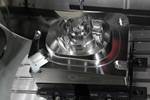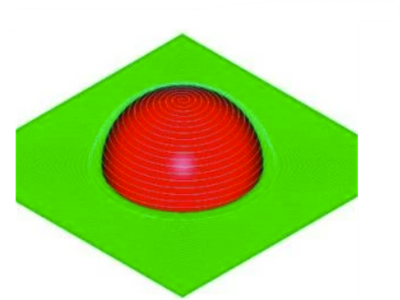
Ball-nose end mill machining a mold component. Source (All Images) | Guhring Inc.
Mold machining can be rigorous, placing high demands on cutting tools, which requires a careful cutting tool selection process. Here are four industry trends/challenges and their cutting tool considerations when identifying the most effective solution.
1. Process Stability
Mold builders experience a lot of pressure every day. On the one hand, they are in constant competition with foreign companies. On the other hand, they are finding it harder and harder to employ skilled workers. All of this leads to an increase in the need for automation. However, to avoid any manual rework, automation demands standardized processes that deliver consistently high-quality product.

Cutting tools fresh out of a coating chamber.
Reliable cutting tools with a long tool life are crucial for automation, which is why it makes sense to consider cutting tools that use coatings specially designed for moldmaking. An ideal coating provides an extremely smooth surface finish, both in the flutes and at the cutting edge, while also offering exceptional heat and wear resistance. This helps to improve chip formation and evacuation, reduce material build-up at the cutting edge and protect the cutting edges from premature tool wear. When combined with a carbide grade that offers the ideal balance of hardness and toughness and tool geometry purposefully designed for the specific workpiece materials, tool life is maximized.
2. Tight Tolerances
Moldmaking is also tight-tolerance work. CAD/CAM is vital to producing this industry’s complex contours, where a component’s digital twin is transferred to the material with the highest possible accuracy. This demands a cutting tool with a long life and a high degree of accuracy when it comes to the radius and line shape.
Milling cutters specifically intended for use in moldmaking, like ballnose end mills and torus end mills, are designed to produce high-precision component features with high angular and contour accuracy. A stable core geometry and optimized flute profile increase cutting tool stability and reduce deflection during machining operations. These cutting tools should be manufactured with shank tolerances in the h5 range with micro-precise accuracy in diameter, concentricity and form, with radius tolerances in the range of ±5 microns.
In using cutting tools made to the highest level of precision and tolerancing, moldmakers can ensure repeatable accuracy, which eliminates costly rework and post-machining operations by minimizing deviations in the geometry of the mold components and finished products.
Internal cutting tool cooling ensures effective, precise cooling and as a result, reliable chip evacuation.
3. Miniaturization and Tight Cavities

End mill detailing the coolant holes in the shank.
Micromachining continues to grow as companies try to save resources by decreasing the thicknesses of the walls in their products. This reduction in wall thickness leads to smaller mold features, making them more fragile and demanding more accuracy. This means cutting tools must be even smaller and longer to machine the deep recesses and hard-to-access cavities in these small components.
To reduce manufacturing times, moldmakers are also motivated to replace time-consuming EDM operations with milling operations, which results in a constant need to produce deeper cavities with even smaller cutting tool diameters. This presents a risk of chips remaining in the flute and damaging the cutter or workpiece surface during milling. With external cooling, it is almost impossible to remove chips from the narrow, low-lying ribs safely.
An alternative solution is internal cutting tool cooling that ensures effective, precise cooling and as a result, reliable chip evacuation. Implementing internal cooling features can be challenging for small-diameter tools. In these cases, the cutting tool manufacturers may incorporate coolant holes into the shank of the tool, which then exits the tool below the shank and directs the coolant precisely to the cutting edge.
4. Difficult-to-Machine Components
Mold components are not only getting smaller but also becoming more difficult to machine due to the materials being used. As the demand for consumer goods continues to rise, so does the batch sizes of finished goods. This puts greater demand on the mold, mold components and hot runner systems.
To withstand higher run cycles, moldmakers are selecting harder and more corrosion-resistant materials for their tooling, for example, hardened tool steels and stainless steels. To efficiently machine these materials, cutting tools made from ultra-hard, carbide substrates are preferred as they offer excellent cutting edge stability due to the smaller grain structure. This leads to a longer and more reliable tool life. Since the cutting tool holds up better, there are fewer deviations of the precision-ground form, which facilitates a higher quality mold, ultimately resulting in a higher quality finished product. Additionally, the benefits of enhanced productivity and efficiency within the manufacturing process lead to higher profits.
Mastering the challenges moldmakers face requires a combination of expertise, automation and the use of specialized tools adapted to the unique demands of the industry. By investing in these areas, moldmakers can navigate the competitive landscape and develop more reliable, precise and efficient manufacturing strategies.
Related Content
6 Ways to Optimize High-Feed Milling
High-feed milling can significantly outweigh potential reliability challenges. Consider these six strategies in order to make high-feed milling successful for your business.
Read MoreMaintaining a Wire EDM Machine
To achieve the ultimate capability and level of productivity from your wire EDM on a consistent, repeatable and reliable basis, regular maintenance is a required task.
Read MoreHow to Eliminate Chatter
Here are techniques commonly used to combat chatter and guidelines to establish a foundation for optimizing the moldmaking process.
Read MoreThe Ins and Outs of Hot Runner Temperature Control
A training checklist that explains the why and how of proper hot runner temperature control and system management.
Read MoreRead Next
How to Overcome Cutting Tool Vibration
Advanced indexable milling cutting tool design provides secure, predictable machining, increased metal removal rates, reduced cycle times and fast changeovers.
Read MoreTen Things You Need to Know about Circle Segment Milling
Considerations for evaluating if circle segment end mills or conical barrel cutters are right for your mold machining applications.
Read More











.png;maxWidth=300;quality=90)










.png;maxWidth=970;quality=90)